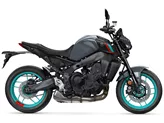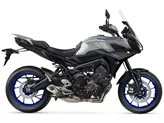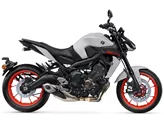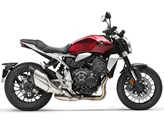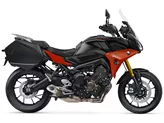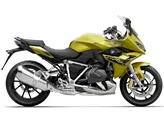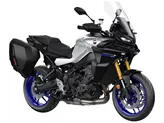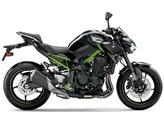Kawasaki Z 800 2013 vs. Yamaha MT-09 2016

Kawasaki Z 800 2013

Yamaha MT-09 2016
Vue d’ensemble - Kawasaki Z 800 2013 vs Yamaha MT-09 2016
In terms of engine and drive train, both the Kawasaki Z 800 2013 and the Yamaha MT-09 2016 have an inline engine type. However, the Yamaha MT-09 has a slightly higher engine power of 115 HP compared to the Kawasaki Z 800's 113 HP. The torque is also higher in the Yamaha MT-09 with 87.5 Nm compared to the Kawasaki Z 800's 83 Nm. The Yamaha MT-09 has three cylinders while the Kawasaki Z 800 has four. The displacement is also higher in the Yamaha MT-09 with 847 ccm compared to the Kawasaki Z 800's 806 ccm.
In terms of suspension, the Kawasaki Z 800 2013 has an upside-down telescopic fork for the front suspension, while the Yamaha MT-09 2016 has a telescopic fork.
In terms of chassis, the Kawasaki Z 800 2013 has a steel frame, while the Yamaha MT-09 2016 has an aluminum frame. The frame type of the Kawasaki Z 800 is a double cradle, while the Yamaha MT-09 has a twin tube frame type.

Kawasaki Z 800 2013
Both bikes have double disk brakes at the front. The front tire width and diameter are the same for both bikes, with a width of 120 mm and a diameter of 17 inches. The rear tire width and diameter are also the same for both bikes, with a width of 180 mm and a diameter of 17 inches.
The wheelbase of the Kawasaki Z 800 2013 is slightly longer at 1445 mm compared to the Yamaha MT-09 2016's 1440 mm. The seat height of the Kawasaki Z 800 is higher at 834 mm compared to the Yamaha MT-09's 815 mm. The kerb weight of the Kawasaki Z 800 is heavier at 229 kg compared to the Yamaha MT-09's 188 kg. The fuel tank capacity of the Kawasaki Z 800 is larger at 17 liters compared to the Yamaha MT-09's 14 liters.
In terms of strengths, the Kawasaki Z 800 2013 has an eye-catching, chunky look. It also has confident acceleration and a relaxed geometry, making it comfortable for long rides. The powerful brakes of the Kawasaki Z 800 provide excellent stopping power.

Yamaha MT-09 2016
On the other hand, the Yamaha MT-09 2016 has a wonderfully powerful three-cylinder powerplant. It also has three power modes, allowing the rider to adjust the performance according to their preference. The fully adjustable chassis of the Yamaha MT-09 provides a customizable riding experience. The quickshifter as standard is a convenient feature, and the sporty upright seating position adds to the bike's agility. The Yamaha MT-09 also has good brakes and aggressive looks, making it visually appealing. The inclusion of traction control enhances safety.
In terms of weaknesses, the Kawasaki Z 800 2013 has limited freedom of movement for the legs, which may affect rider comfort on long rides.
On the other hand, the Yamaha MT-09 2016 has a saddle that is a little too hard for long tours, which may cause discomfort during extended rides. Additionally, the license plate holder on the swingarm offers less splash protection than a conventional one, which may result in more dirt and water splashing onto the rider and the bike.
Caractéristiques techniques Kawasaki Z 800 2013 par rapport à Yamaha MT-09 2016
Avantages et inconvénients en comparaison
Avantages et inconvénients en comparaison
Kawasaki Z 800 2013

Dans l'ensemble, la Z800 a livré une performance sensationnelle. Compte tenu du fait que rien n'a été modifié ou optimisé sur le véhicule, à l'exception du pot d'échappement Remus, le résultat final est superbe.
Yamaha MT-09 2016

La Yamaha MT-09 n'a pas eu besoin d'être réinventée pour la saison à venir - elle l'a déjà été extrêmement bien il y a à peine quatre ans. Au lieu de cela, les Japonais ont misé sur un réglage fin et l'ajout de gadgets pratiques, adaptés à l'époque, comme le contrôle de traction et le changement de vitesse automatique. La norme Euro4 a une fois de plus modifié la gestion du moteur qui, en mode standard, offre un développement de la puissance certes puissant, mais bien contrôlable. Le plus grand changement, reconnaissable au premier coup d'œil, est le design, à mon avis très réussi, avec l'avant plus agressif et l'arrière redessiné. Dans l'ensemble, il s'agit donc d'une naked bike encore plus élégante, qui a clairement été construite pour le plaisir de conduire une moto.
Comparaison des prix Prix moyen du marché Kawasaki Z 800 vs Yamaha MT-09
There are a few key differences between a Kawasaki Z 800 2013 and a Yamaha MT-09 2016. In terms of price, the actual average price of a Yamaha MT-09 2016 is about 15% higher. Compared to Yamaha MT-09 2016 there are less Kawasaki Z 800 2013 bikes available on the 1000PS.de Marketplace, specifically 7 compared to 11. It takes less time to sell a Kawasaki Z 800 with 56 days compared to 87 days for a Yamaha MT-09. Since model year 2013 1000PS.de editors have written 11 reviews for the Kawasaki Z 800 and 57 reviews for the Yamaha MT-09 since model year 2013. The first review for the Kawasaki Z 800 was published on 9/6/2012 and now has more than 8,100 views. This compares to more than 39,900 views for the first review on Yamaha MT-09 published on 6/10/2013.



